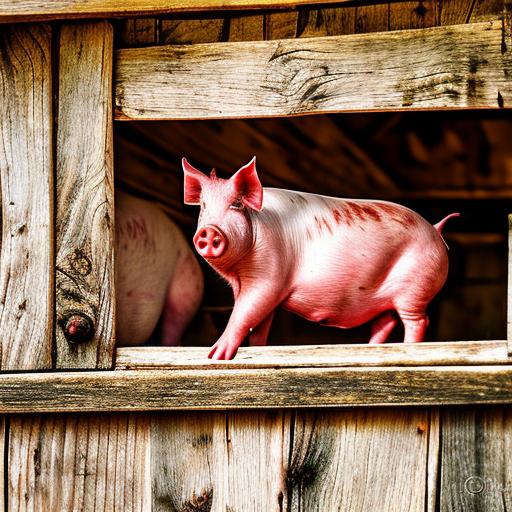Keeping chickens and pigs together is a practice that has gained popularity among small-scale farmers and homesteaders. This practice offers several benefits, such as reduced feed costs and improved soil health. However, there are also challenges that need to be considered before embarking on this endeavor. In this article, we will explore the benefits of keeping chickens and pigs together, as well as the factors to consider, tips for preparation, creating a safe living environment, feeding both animals together, managing waste and hygiene, addressing potential health risks, and tips for successfully raising chickens and pigs together.
Key Takeaways
- Keeping chickens and pigs together can have numerous benefits, including reduced feed costs and increased waste management efficiency.
- Before deciding to keep chickens and pigs together, it is important to consider factors such as space requirements, temperament, and potential health risks.
- Preparing the chicken coop for pigs involves ensuring that the structure is sturdy and secure, and providing adequate space and resources for both animals.
- Creating a safe and comfortable living environment for chickens and pigs involves providing separate areas for feeding and nesting, and ensuring that the animals have access to clean water and appropriate bedding.
- Feeding chickens and pigs together requires careful consideration of their dietary needs and preferences, and may involve supplementing their diets with additional nutrients.
Benefits of Keeping Chickens and Pigs Together
One of the main benefits of keeping chickens and pigs together is reduced feed costs. Pigs are omnivorous animals and can consume a wide variety of food, including kitchen scraps, garden waste, and surplus crops. By allowing pigs to forage in the same area as the chickens, they can eat insects, worms, and other small creatures that the chickens may not be able to reach. This reduces the amount of commercial feed required for both animals.
Another benefit is improved soil health. Pigs have a natural instinct to root and dig in the soil, which helps to aerate it and break up compacted areas. This can improve drainage and nutrient availability for plants. Additionally, the manure produced by both chickens and pigs is rich in nutrients and can be used as fertilizer for crops or composted to improve soil fertility.
Personal experiences or anecdotes can help illustrate these benefits. For example, a farmer may share how they noticed an increase in egg production after introducing pigs to their chicken coop. They may also mention how their garden flourished after allowing pigs to roam in the area where the chickens were kept.
Factors to Consider Before Keeping Chickens and Pigs Together
Before keeping chickens and pigs together, it is important to consider several factors. First, space is a crucial consideration. Both chickens and pigs require adequate space to move around and exhibit natural behaviors. It is important to ensure that the coop and outdoor area are large enough to accommodate both animals comfortably.
Temperament is another factor to consider. Pigs can be aggressive towards chickens, especially if they feel threatened or if there is competition for food. It is important to assess the temperament of both animals and ensure that they can coexist peacefully.
Local regulations should also be taken into account. Some areas may have restrictions on keeping certain animals together or may require specific permits or licenses. It is important to research and comply with any regulations before starting this practice.
Assessing whether keeping chickens and pigs together is a good idea for your specific situation can be done by observing the behavior of both animals. If they are already living in close proximity and seem to get along well, it may be a good indication that they can be kept together. However, if there are signs of aggression or stress, it may be best to keep them separate.
Preparing the Chicken Coop for Pigs
Preparing a chicken coop for pigs involves several steps. First, it is important to reinforce the fencing to ensure that pigs cannot escape or damage the coop. Pigs are strong and can easily knock down flimsy fencing. Adding additional support or using sturdy materials such as welded wire or hog panels can help prevent escape.
Additional space should also be provided for the pigs. Pigs require more space than chickens, so it is important to ensure that there is enough room for them to move around comfortably. This can be achieved by expanding the outdoor area or creating a separate enclosure within the coop.
It is also important to consider the flooring of the coop. Pigs have a tendency to root and dig in the soil, which can lead to erosion or damage to the coop floor. Providing a solid concrete or compacted dirt floor can help prevent this.
Creating a Safe and Comfortable Living Environment for Chickens and Pigs
Creating a safe and comfortable living environment for both chickens and pigs is essential for their well-being. Adequate shelter should be provided to protect them from extreme weather conditions such as heat, cold, or rain. This can be achieved by providing a well-insulated coop with proper ventilation and shade.
Both animals also require access to clean water and nutritious food. Separate feeding and watering stations should be provided to prevent competition and ensure that each animal gets their fair share. It is important to regularly clean and refill these stations to maintain hygiene.
Bedding material should also be provided to keep the animals comfortable and prevent the buildup of waste. Straw, wood shavings, or sawdust can be used as bedding material. Regularly cleaning and replacing the bedding will help maintain a clean and odor-free environment.
Feeding Chickens and Pigs Together

Feeding chickens and pigs together can have its benefits, but it also comes with challenges. Pigs have a tendency to eat quickly and aggressively, which can lead to them consuming all the food before the chickens have a chance to eat. To overcome this challenge, it is important to provide separate feeding stations for each animal.
Feeding pigs first can help ensure that they are satisfied before the chickens are given access to their food. This can prevent aggression or competition between the animals. It is also important to monitor the feeding process and make adjustments as needed to ensure that both animals are receiving adequate nutrition.
Managing Waste and Hygiene in a Shared Coop
Managing waste and maintaining good hygiene in a shared coop is crucial for the health of both animals. Regular cleaning of the coop is necessary to prevent the buildup of waste, which can attract pests or lead to the spread of disease.
Separate areas for waste management should be provided for each animal. For example, a separate area can be designated for the pigs to relieve themselves, while the chicken coop can have a separate area for their waste. This can help prevent cross-contamination and maintain hygiene.
Regularly removing and composting the waste can help reduce odors and improve the overall cleanliness of the coop. It is important to follow proper composting practices to ensure that the compost is safe to use as fertilizer.
Addressing Potential Health Risks
Keeping chickens and pigs together can pose potential health risks, such as the spread of disease. Pigs are known carriers of certain diseases that can be transmitted to chickens, such as swine flu or salmonella. It is important to monitor the health of both animals regularly and seek veterinary care if any signs of illness are observed.
To minimize the risk of disease transmission, it is important to practice good biosecurity measures. This includes keeping the coop clean, preventing contact between sick and healthy animals, and practicing proper hygiene when handling both chickens and pigs.
Regular vaccinations and deworming should also be carried out to prevent the spread of parasites or other diseases. Consulting with a veterinarian can help develop a vaccination and deworming schedule that is appropriate for both animals.
Tips for Raising Chickens and Pigs Together
Here are some additional tips and advice for successfully raising chickens and pigs together:
1. Provide plenty of space: Both animals require adequate space to move around comfortably. Providing enough space will help prevent aggression and stress.
2. Monitor behavior: Regularly observe the behavior of both animals to ensure that they are getting along well. Address any signs of aggression or stress immediately.
3. Separate feeding stations: Provide separate feeding stations for each animal to prevent competition and ensure that they are receiving adequate nutrition.
4. Regular cleaning: Regularly clean the coop to prevent the buildup of waste and maintain good hygiene.
5. Seek veterinary care: Monitor the health of both animals regularly and seek veterinary care if any signs of illness are observed.
Conclusion and Final Thoughts
Keeping chickens and pigs together can offer several benefits, such as reduced feed costs and improved soil health. However, it is important to consider factors such as space, temperament, and local regulations before embarking on this endeavor. By preparing the chicken coop for pigs, creating a safe and comfortable living environment, feeding both animals together, managing waste and hygiene, addressing potential health risks, and following the tips provided, it is possible to successfully raise chickens and pigs together. With proper planning and care, this practice can be a rewarding and sustainable way to raise animals on a small-scale farm or homestead.
If you’re considering keeping chickens and pigs together, it’s important to understand the dynamics and requirements of both animals. While they can coexist in some situations, it’s crucial to provide adequate space and separate housing to ensure their well-being. To learn more about creating the ideal living environment for your chickens, check out this informative article on “What Kind of Coop is Best for Chickens” at Poultry Wizard. Additionally, if you’re interested in incorporating a garden into your chicken coop setup, this article on “Garden Chicken Coop” offers valuable insights and tips.
FAQs
What are the benefits of keeping chickens and pigs together?
Keeping chickens and pigs together can have several benefits. Chickens can help to keep the pig’s living area clean by eating insects and parasites, while pigs can help to till and fertilize the soil for the chickens to forage.
Is it safe to keep chickens and pigs together?
Yes, it is generally safe to keep chickens and pigs together as long as certain precautions are taken. Chickens should have a separate roosting area to prevent them from being trampled by the pigs, and pigs should have access to a separate feeding area to prevent them from eating the chicken’s food.
What should I feed my chickens and pigs if I keep them together?
Chickens and pigs have different dietary needs, so it is important to provide them with separate feed. Chickens require a diet high in protein, while pigs require a diet high in carbohydrates. Consult with a veterinarian or animal nutritionist to determine the best feed for your animals.
What kind of housing do chickens and pigs need if kept together?
Chickens and pigs should have separate housing areas to prevent any potential conflicts. Chickens require a roosting area that is elevated off the ground, while pigs require a sheltered area that is protected from the elements.
What are some potential problems with keeping chickens and pigs together?
One potential problem with keeping chickens and pigs together is that pigs may accidentally injure or kill chickens if they are not properly supervised. Additionally, pigs may eat the chicken’s food, which can lead to malnutrition for the chickens. It is important to monitor the animals closely and provide separate living and feeding areas to prevent any conflicts.
Meet Walter, the feathered-friend fanatic of Florida! Nestled in the sunshine state, Walter struts through life with his feathered companions, clucking his way to happiness. With a coop that’s fancier than a five-star hotel, he’s the Don Juan of the chicken world. When he’s not teaching his hens to do the cha-cha, you’ll find him in a heated debate with his prized rooster, Sir Clucks-a-Lot. Walter’s poultry passion is no yolk; he’s the sunny-side-up guy you never knew you needed in your flock of friends!







